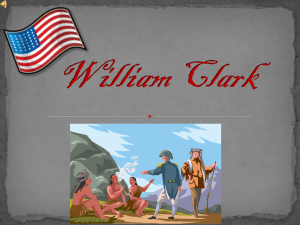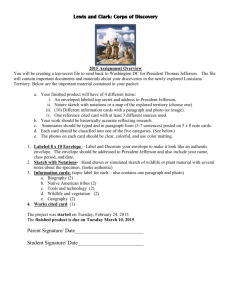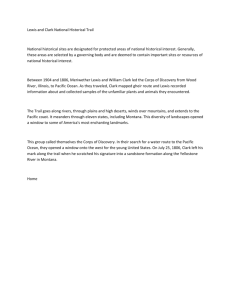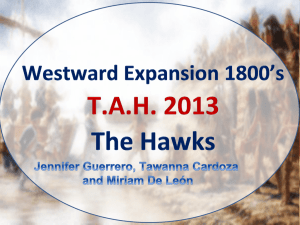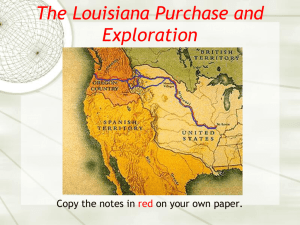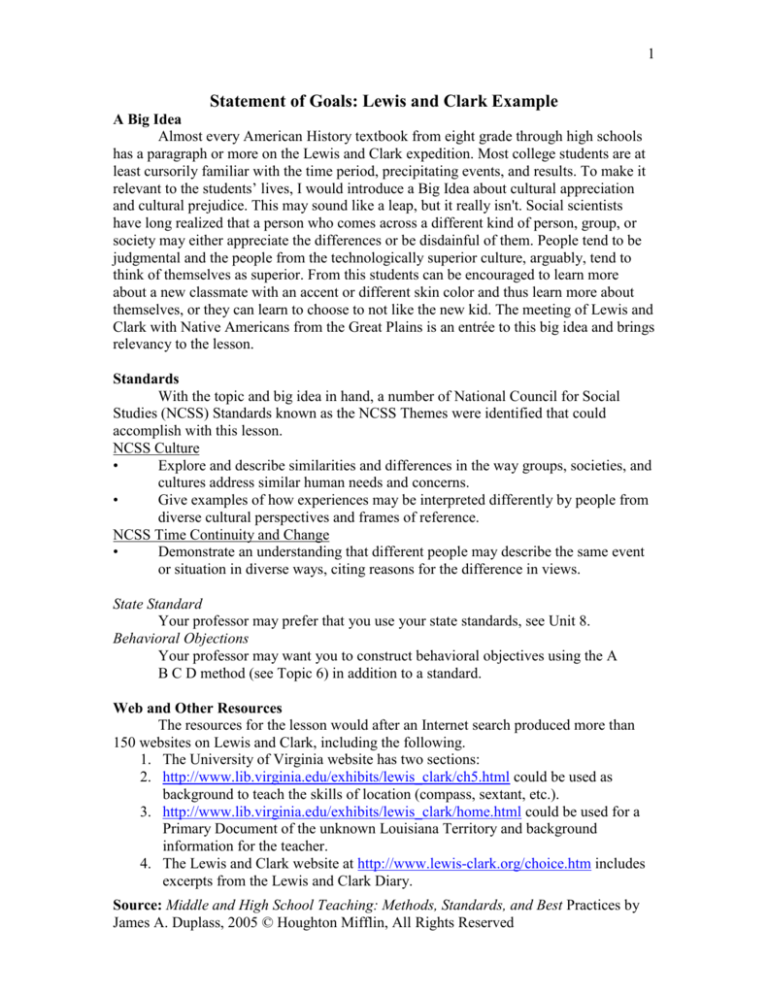
1
Statement of Goals: Lewis and Clark Example
A Big Idea
Almost every American History textbook from eight grade through high schools
has a paragraph or more on the Lewis and Clark expedition. Most college students are at
least cursorily familiar with the time period, precipitating events, and results. To make it
relevant to the students’ lives, I would introduce a Big Idea about cultural appreciation
and cultural prejudice. This may sound like a leap, but it really isn't. Social scientists
have long realized that a person who comes across a different kind of person, group, or
society may either appreciate the differences or be disdainful of them. People tend to be
judgmental and the people from the technologically superior culture, arguably, tend to
think of themselves as superior. From this students can be encouraged to learn more
about a new classmate with an accent or different skin color and thus learn more about
themselves, or they can learn to choose to not like the new kid. The meeting of Lewis and
Clark with Native Americans from the Great Plains is an entrée to this big idea and brings
relevancy to the lesson.
Standards
With the topic and big idea in hand, a number of National Council for Social
Studies (NCSS) Standards known as the NCSS Themes were identified that could
accomplish with this lesson.
NCSS Culture
•
Explore and describe similarities and differences in the way groups, societies, and
cultures address similar human needs and concerns.
•
Give examples of how experiences may be interpreted differently by people from
diverse cultural perspectives and frames of reference.
NCSS Time Continuity and Change
•
Demonstrate an understanding that different people may describe the same event
or situation in diverse ways, citing reasons for the difference in views.
State Standard
Your professor may prefer that you use your state standards, see Unit 8.
Behavioral Objections
Your professor may want you to construct behavioral objectives using the A
B C D method (see Topic 6) in addition to a standard.
Web and Other Resources
The resources for the lesson would after an Internet search produced more than
150 websites on Lewis and Clark, including the following.
1. The University of Virginia website has two sections:
2. http://www.lib.virginia.edu/exhibits/lewis_clark/ch5.html could be used as
background to teach the skills of location (compass, sextant, etc.).
3. http://www.lib.virginia.edu/exhibits/lewis_clark/home.html could be used for a
Primary Document of the unknown Louisiana Territory and background
information for the teacher.
4. The Lewis and Clark website at http://www.lewis-clark.org/choice.htm includes
excerpts from the Lewis and Clark Diary.
Source: Middle and High School Teaching: Methods, Standards, and Best Practices by
James A. Duplass, 2005 © Houghton Mifflin, All Rights Reserved
2
5. The National Park Service website at http://www.nps.gov/lecl/ provides
information about the Lewis and Clark Trail.
6. The PBS website at http://www.pbs.org/lewisandclark/native/index.html has
pictures of Native Americans.
7. The NACIREMA http://www.msu.edu/~jdowell/miner.html
Information Knowledge
1. President Jefferson's purchase of the Louisiana Territory
2. The decision to have Lewis and Clark explore and map the territory
3. The expedition timeline and route, with location maps and current-day locations
4. Primary Document such as Jefferson’s letters to Lewis.
5. Images and maps of the Northwest territory from the Internet
6. Cultural comparison of Great Plains and Northeast Indian nations (food, clothing,
dwelling, as functions of climate and geography) using the Key Social Science
Questions
Procedural Knowledge
The following procedural knowledge applications are drawn from the NCSS
themes; the modes of reasoning of history, social sciences, and geography; and the NCSS
Social Studies Essential Skills.
1. Hypothesizing about monuments, vis-à-vis the Jefferson Memorial.
2. Interpreting Primary Documents such as the Lewis and Clark Diaries and
Jefferson’s letter commissioning the expedition, which can be found at the
Thomas Jefferson Digital Achieves at http://etext.lib.virginia.edu/jefferson/texts/.
3. Analyzing the interests and values of the various people involved
4. Analyzing cultural-based differences and develop objectivity
5. Developing Chronological thinking
6. Developing factual basis for understanding history
7. Applying the Key Social Science Questions
8. Determine the effects of Location on food, human traits, “race,” shelter, clothing,
etc.
9. Interpret maps
10. Determine cause-and-effect relationships
Basic Skills Knowledge
There are a number of basic skills that will be developed during this lesson. The
students will
1. Read Primary Documents
2. Develop listening skills
3. Communicate beliefs, feelings, and convictions
4. Reflect on ideas and beliefs
5. Map skills
Academic Disposition
With this lesson students should be more open to differences based on culture;
better able to analyze contemporary cultures; and more reflective abut their own culture.
Source: Middle and High School Teaching: Methods, Standards, and Best Practices by
James A. Duplass, 2005 © Houghton Mifflin, All Rights Reserved
3
Daily Lessons
Your professor may want you to briefly describe your planned daily lessons.
Day 1 & 2: The Expedition & Indian Rain Dance
Knowledge: The lesson is the introduction via the Louisiana Purchase and the
actual expedition using historical maps, diaries, primary documents, and
timelines.
Strategies: Lecture with graphic organizers, pre-reading focusing on objects,
group reading, TOADSONLOGS map approach and Socratic method.
Day 3: Cultural Diversity
Knowledge: The lesson is a hypothetical case study in which students are asked to
hypothesize about what an “Indian Rain Dance” is and how Lewis and Clark may
have perceived it coming from their culture. The students are asked to compare
how different cultures (their own and others) develop customs. The goal is to have
students reflect on their own family customs and willingness to accept others who
are different. The second part of the class starts by explaining that the American
Anthropological Association now requries the word “race” to be put in quotes and
the question, “Why”? After a discussion leading to there is no such thing as
“race,” only ethnicity, a review of the history of the word “Race” is used with a
short film clip from the PBS series on human origins, PBS Video Series –
Evolution
Strategies: Discussion, maps of how humans moved across the planet,
compare/contrast lecture of British and German anthropologists use of the word
race, and the Quick Clips approach.
Day 3: Great Plains vs. Northeast First Americans
Knowledge: The lesson provides an anthropological look at the First Americans
and how they developed different living, political, and sociological patterns like
patriarchal and matriarchal lineages, moon and sun worship, hunting vs. farming,
etc.
Strategies: Compare and Contrast charts and Feedback Lecture are used for the
first part of the class. The reading NACIREMA was assigned as homework and
students and a whole class debriefing will be used to decipher who the
NACIREMA people are.
Based on this kind of goal setting, you are prepared to being developing your
Class Notes (see Topic 19)
Source: Middle and High School Teaching: Methods, Standards, and Best Practices by
James A. Duplass, 2005 © Houghton Mifflin, All Rights Reserved

